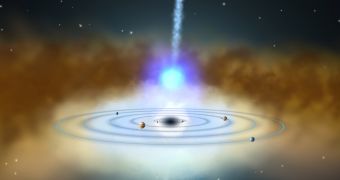A prolonged analysis of the supermassive black hole at the core of the galaxy NGC 4151 revealed signs of a proposed phenomenon called relativistic reverberation. This is produced by mysterious X-ray sources located above the black holes themselves.
Radiations released by these objects bounce from the highly compressed, rapidly spinning accretion disks that compress matter before spilling it beyond black holes' event horizons. Astronomers have thus far been painfully aware that no single reverberation could be detected with today's technologies.
Theoreticians proposed a solution whereby astronomers would observe a single object for a long period of time, and capture multiple instances of relativistic reverberation as a single event. This has recently been accomplished using the European Space Agency (ESA) XMM-Newton spacecraft.
An international collaboration of researchers was behind this study, whose conclusions could now be used to gain a deeper understanding of the environments surrounding distant, supermassive black holes.
Experts define an active galactic nucleus as the core of a galaxy that hosts a very large black hole, with a mass at least several million times that of our Sun. Researchers are studying these objects in order to figure out what happens close to their event horizons.
“Our analysis allows us to probe black holes through a different window. It confirms some long-held ideas about AGN and gives us a sense of what we can expect when a new generation of space-based X-ray telescopes eventually becomes available,” expert Abderahmen Zoghbi says.
He holds an appointment as a postdoctoral research associate at the University of Maryland in College Park (UMCP), and was also the lead author of a new study detailing the findings. The paper appears in the May 8 issue of the journal Monthly Notices of the Royal Astronomical Society.
One way to study this is by looking at the iron K line, a characteristic X-ray signature produced by iron atoms when they are highly excited, to energies of around 6,000 to 7,000 electron volts. In the new research, scientists sought to demonstrate a theoretical property of the iron K line.
Theoreticians proposed some time ago that the flaring of the X-ray source above the black hole would lead to a brightening of the iron K line, but with a time delay related to how long the radiations produced would need in order to travel all the way to the accretion disk, and illuminate it.
It's important to note here that matter in the accretion disk spins so fast that it reaches relativistic speeds (fractions of the speed of light), which is why the effect is called relativistic reverberation.
Since no X-ray telescope today is capable of seeing this effect produced by a single black hole, experts waited until they collected enough data on the core of NGC 4151 to detect the combined echoes of multiple instances of relativistic reverberation.
Investigators with the international team discovered a 30-minute delay between the X-rays coming directly from the source above the black hole, and the radiation that arrived at Earth after bouncing from the accretion disk.
The delay indicates the secondary radiations traveled around 400 million miles (643.7 million kilometers) extra. Complex calculations revealed that this distance – equivalent to around 4 AU – suggests an X-ray source located above the black hole itself, and different from its accretion disk.
“The data show that the earliest echo comes from the most broadened iron line emission. This originates from closest to the black hole and fits well with expectations,” University of Cambridge astrophysicist and study coauthor, Andy Fabian, explains.
“Teasing out the echo of X-ray light in NGC 4151 is a remarkable achievement. This work propels the science of AGN into a fundamental new area of mapping the neighborhoods of supermassive black holes,” comments NASA Goddard Space Flight Center astrophysicist Kimberly Weaver, who was not part of the team.

 14 DAY TRIAL //
14 DAY TRIAL //